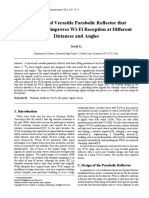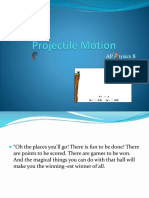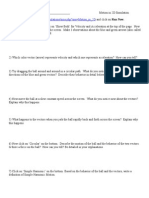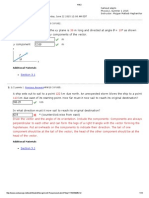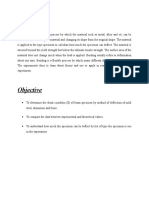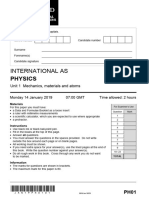2D Motion Lab-1
2D Motion Lab-1
Uploaded by
Muzamil ShahCopyright:
Available Formats
2D Motion Lab-1
2D Motion Lab-1
Uploaded by
Muzamil ShahCopyright
Available Formats
Share this document
Did you find this document useful?
Is this content inappropriate?
Copyright:
Available Formats
2D Motion Lab-1
2D Motion Lab-1
Uploaded by
Muzamil ShahCopyright:
Available Formats
Name ____________________________________ Simulation
Motion in 2D
Go to http://phet.colorado.edu/simulations/sims.php?sim=Motion_in_2D and click on Run Now. 1) Once the simulation opens, click on Show Both for Velocity and Acceleration at the top of the page. Now click and drag the red ball around the screen. Make 3 observations about the blue and green arrows (also called vectors) as you drag the ball around. Ans: When we stop dragging then there is no change in the displacement with time means velocity is zero. By slowly decreasing the velocity the acceleration is produced, which is always appears to be at a 90 angle. 2) Which color vector (arrow) represents velocity and which one represents acceleration? How can you tell? Ans: The green arrow represents velocity and the blue arrow represents acceleration as shown . By draging the red ball we observe that its velocity increases . By slowing the motion of the red ball then deceleration is produced, the deceleration vector is always opposite to acceleration vector.
3) Try dragging the ball around and around in a circular path. What do you notice about the lengths and directions of the blue and green vectors? Describe their behavior in detail below. Ans: By dragging the ball around and around in a circular path the velocity is changing at every point due to change in direction. The green arrow length is changing while the blue arrow remain constant. The body's speed is constant, but its velocity is not constant. This changing velocity indicates the presence of an acceleration( centripetal acceleration). 4) Now move the ball at a slow constant speed across the screen. What do you notice now about the vectors? Explain why this happens. Ans: When we move the red ball with slow constant speed then the velocity is constant and there is barely any acceleration. As there is no change in direction or displacement so there is no acceleration. 5) What happens to the vectors when you jerk the ball rapidly back and forth across the screen? Explain why this happens. Ans: When we jerked the ball rapidly back and forth across the screen the velocity of the changes quickly so tht acceleration increases rapidly. The vector for acceleration becoming large and stretch across as well.
6) Now click on Circular on the bottom. Describe the motion of the ball and the behavior of the two vectors. Is there a force on the ball? How can you tell? Be detailed in your explanations. Ans: Uniform circular motion is the motion of an object in a circle at a constant speed. As the ball moves in a circle, it is constantly changing its direction. The radius of the circle is always fixed i,e blue arrow . Though the body's speed is constant, its velocity is not constant due to change in direction. This changing velocity indicates the presence of centripetal acceleration is of constant magnitude and directed at all times towards the axis of rotation. Due to the centripetal acceleration there is a constant force called centripetal force. 7) Click on Simple Harmonic on the bottom. Based on the behavior of the ball and the vectors, write a definition of Simple Harmonic Motion. Ans: Simple Harmonic Motion are the vibrations whose time period stays the same although its amplitude changes. When we are moving the ball to the lift of the screen the green arrow magnitude is increasing and at the center green arrow is maximum, and the blue arrow is small and in the direction of green arrow with small blue arrow. When the ball at the left extent of the screen the green arrow is zero and the blue arrow direction is towards the center. On coming back towards the center the green arrow is increasing at the center green arrow is maximum again. On going to right the green arrow is decreasing and the blue arrow direction is towards center. At the right extent of the screen the green arrow becomes zero and due to restoring force the red ball come back to the center.
You might also like
- Sample Lesson PlanDocument2 pagesSample Lesson PlanGeneven Hermosa Olasiman0% (1)
- Factors Affect-Mass Spring-PhetDocument4 pagesFactors Affect-Mass Spring-Phetzayed100% (1)
- Law of Sines 2Document4 pagesLaw of Sines 2Haris AhmedNo ratings yet
- CH 23 HW1 PDFDocument35 pagesCH 23 HW1 PDFMuzamil Shah100% (4)
- FeederDocument13 pagesFeedernileshNo ratings yet
- ASCI 309 Independent ProjectDocument6 pagesASCI 309 Independent ProjectPhillip ReedNo ratings yet
- Number SystemDocument8 pagesNumber SystemEjaz AhmadNo ratings yet
- Science Grade 7-3 Quarter (Physics)Document8 pagesScience Grade 7-3 Quarter (Physics)Sarring EddingNo ratings yet
- Science 10 U2M1A2Document3 pagesScience 10 U2M1A2Angel OrdialesNo ratings yet
- As If Its Your LastDocument6 pagesAs If Its Your LastBot Ching MacRiverNo ratings yet
- Summative Test (Mapeh-7)Document5 pagesSummative Test (Mapeh-7)Erika QuindipanNo ratings yet
- Q1-Week 1 - Find The CenterDocument21 pagesQ1-Week 1 - Find The CenterFrenzy Mei JobleNo ratings yet
- Analytic Geometry 1st Quarter ReviewerDocument4 pagesAnalytic Geometry 1st Quarter ReviewerfebofNo ratings yet
- Eyelid: /'beauty: The Korean Way by Julia YooDocument5 pagesEyelid: /'beauty: The Korean Way by Julia Yoosos ciliNo ratings yet
- Literature Review Weaving in EthiDocument8 pagesLiterature Review Weaving in EthiSinte AyeleNo ratings yet
- Types of Hand Signals in VolleyballDocument2 pagesTypes of Hand Signals in VolleyballMarriane MarieNo ratings yet
- Central Angle and Its Intercepted ArcDocument5 pagesCentral Angle and Its Intercepted ArcAnne MalobagoNo ratings yet
- Angle of Incidence Vs Angle of ReflectionDocument19 pagesAngle of Incidence Vs Angle of ReflectionJj AlimasacNo ratings yet
- Solve Problems On Tangents and Secants of CirclesDocument32 pagesSolve Problems On Tangents and Secants of CirclesLeslie Ann RojoNo ratings yet
- 01 2 Strings PDFDocument11 pages01 2 Strings PDFReddyvari VenugopalNo ratings yet
- Grade8 Q4 SummativeDocument7 pagesGrade8 Q4 Summativekevin omayNo ratings yet
- Biology Lab Report 1Document4 pagesBiology Lab Report 1Eunacia Canizares0% (1)
- October 142020Document52 pagesOctober 142020Salve SerranoNo ratings yet
- Example:: Opposite Adjacent y y 67 Tan 70 ° y 184 MDocument2 pagesExample:: Opposite Adjacent y y 67 Tan 70 ° y 184 MJessa Lou Liba CapapasNo ratings yet
- Body Part Metaphors in EkitiDocument7 pagesBody Part Metaphors in EkitiAlexandra O'NeilNo ratings yet
- PRE-CALCULUS - MODULE - Week 3Document16 pagesPRE-CALCULUS - MODULE - Week 3Azur LaneNo ratings yet
- Games For Foundation DayDocument2 pagesGames For Foundation DayKimberly Mae Bagante0% (1)
- Human Interaction OutlineDocument8 pagesHuman Interaction OutlineSamuel Lim AgbanlogNo ratings yet
- English 6 Q3 W5Document15 pagesEnglish 6 Q3 W5John Rich CaidicNo ratings yet
- Wifi Parabolic Antenna (Sapub) 10.5923 J JWNC 20130302.02Document5 pagesWifi Parabolic Antenna (Sapub) 10.5923 J JWNC 20130302.02Luciano Romanini AlbertiNo ratings yet
- Physical Education - ArnisDocument52 pagesPhysical Education - ArnisMary Noliza SabanNo ratings yet
- Week1 - Analogy To Show Relationships of WordsDocument12 pagesWeek1 - Analogy To Show Relationships of WordsTeacher Dee TVNo ratings yet
- Module 1 QuadrilateralsDocument13 pagesModule 1 QuadrilateralsMaris StellahNo ratings yet
- Aim 41 Piecewise Word ProblemsDocument4 pagesAim 41 Piecewise Word ProblemsleapZeeg Surrealist100% (1)
- Lens Equations Lesson PPTDocument12 pagesLens Equations Lesson PPTAmelia Rahmawati100% (1)
- Physics 121 Practice Problem Solutions 11 Faraday's Law of InductionDocument13 pagesPhysics 121 Practice Problem Solutions 11 Faraday's Law of InductionJosh'z LlamesNo ratings yet
- Inter Schools Quiz QuestionsDocument46 pagesInter Schools Quiz QuestionsMuhammad Kabeer100% (1)
- Math7 q4 Mod5 MeasuresOfCentralTendency v1 PDFDocument24 pagesMath7 q4 Mod5 MeasuresOfCentralTendency v1 PDFfrank adrianoNo ratings yet
- Sci 8 Lesson 6 Power in PhysicsDocument11 pagesSci 8 Lesson 6 Power in PhysicsTorres Jhon Chriz GabrielNo ratings yet
- PE - Q3 Module 2 - Team Sport Volleyball ServeDocument6 pagesPE - Q3 Module 2 - Team Sport Volleyball ServeGinger gwapoNo ratings yet
- Module 10 (Music 1.1)Document33 pagesModule 10 (Music 1.1)Dafchen Nio MahasolNo ratings yet
- Criteria For Powerpoint PresentationDocument1 pageCriteria For Powerpoint PresentationChristian Dominic Ona100% (1)
- Assessment Tool DuringDocument2 pagesAssessment Tool DuringEros Cuesta100% (1)
- Arts7 Module1 Powerpoint For Online 2Document33 pagesArts7 Module1 Powerpoint For Online 2SkinScript Creator50% (2)
- Module in Arts 10 Week 5 6Document23 pagesModule in Arts 10 Week 5 6Rose ValenzuelaNo ratings yet
- 3rd Grading Summative TestsDocument8 pages3rd Grading Summative TestsRussel John FogataNo ratings yet
- Raymart Rona Quarter 1Document7 pagesRaymart Rona Quarter 1John Ray RonaNo ratings yet
- Secondary P.E. 9 Q4 Module2Document12 pagesSecondary P.E. 9 Q4 Module2Mateo KaiNo ratings yet
- Electromagnetic Induction - ProblemsDocument3 pagesElectromagnetic Induction - ProblemsHarikrishnan NamboothiriNo ratings yet
- Chapter 3-The Parabola 3 PDFDocument125 pagesChapter 3-The Parabola 3 PDFChristine FernandezNo ratings yet
- Projectile Motion gr9Document18 pagesProjectile Motion gr9Yuko IlaganNo ratings yet
- Math 8 - Lesson 4Document15 pagesMath 8 - Lesson 4Jumedeluna05yahoo.com Jumelynjumelyn199411No ratings yet
- Q3 - Grade9 - Dance Interpretation 1Document23 pagesQ3 - Grade9 - Dance Interpretation 1Maria Cristina Reyes33% (3)
- By Castro, Et. Al. (Phoenix Publishing House) : Everyday English That Really Works Grade 7Document8 pagesBy Castro, Et. Al. (Phoenix Publishing House) : Everyday English That Really Works Grade 7Christian CalozaNo ratings yet
- Learning Activity Sheet: ExploreDocument3 pagesLearning Activity Sheet: ExploreSHERYL NOVA100% (2)
- Biological Hazard Radio ScriptDocument2 pagesBiological Hazard Radio ScriptLilianna100% (1)
- Gymnastics - Newton's LawsDocument4 pagesGymnastics - Newton's Lawscassiejoness100% (2)
- Math Teachers Guide8Document71 pagesMath Teachers Guide8Kenzei AzumiNo ratings yet
- Lab Activity Chapter 1Document3 pagesLab Activity Chapter 1Ahsan AliNo ratings yet
- Phet 2D Motion ActivityDocument1 pagePhet 2D Motion ActivityifriessNo ratings yet
- Sample Data Motion MatchingDocument5 pagesSample Data Motion Matchingdelano619No ratings yet
- Activity Guide & Answer Sheet Activity 6-Uniform Circular MotionDocument5 pagesActivity Guide & Answer Sheet Activity 6-Uniform Circular MotionRonel AlbanNo ratings yet
- G Science PDFDocument177 pagesG Science PDFTaslima TabassumNo ratings yet
- Solar SystemDocument23 pagesSolar SystemMuzamil ShahNo ratings yet
- The Big Bang TheoryDocument28 pagesThe Big Bang TheoryMuzamil ShahNo ratings yet
- CH 29 HW PDFDocument36 pagesCH 29 HW PDFMuzamil Shah50% (2)
- CH 29 HW PDFDocument36 pagesCH 29 HW PDFMuzamil Shah50% (2)
- Questions AnswerDocument3 pagesQuestions AnswerMuzamil ShahNo ratings yet
- CH 28 HW PDFDocument44 pagesCH 28 HW PDFMuzamil Shah100% (3)
- CH 31 HWDocument34 pagesCH 31 HWMuzamil Shah100% (1)
- The Expert TA - 3aaDocument6 pagesThe Expert TA - 3aaMuzamil ShahNo ratings yet
- Thermodynamic HWDocument9 pagesThermodynamic HWMuzamil ShahNo ratings yet
- Chap6 PDFDocument23 pagesChap6 PDFMuzamil ShahNo ratings yet
- Error Analysis NotesDocument10 pagesError Analysis NotesMuzamil Shah100% (1)
- The Expert TA - 3 PDFDocument6 pagesThe Expert TA - 3 PDFMuzamil ShahNo ratings yet
- Townsend, Problem 10Document22 pagesTownsend, Problem 10Muzamil ShahNo ratings yet
- Correlator Solution: 1 Collocation MethodDocument10 pagesCorrelator Solution: 1 Collocation MethodMuzamil ShahNo ratings yet
- PHY 2048: Physic 1, Discussion Section 3695 Quiz 2 (Homework Set #3)Document1 pagePHY 2048: Physic 1, Discussion Section 3695 Quiz 2 (Homework Set #3)Muzamil ShahNo ratings yet
- P9826 HW2 2013Document5 pagesP9826 HW2 2013Muzamil ShahNo ratings yet
- Explanation Phenomenon Scientific Method TestDocument13 pagesExplanation Phenomenon Scientific Method TestMuzamil ShahNo ratings yet
- Admission Guide: Fall Semester 2015Document11 pagesAdmission Guide: Fall Semester 2015Muzamil ShahNo ratings yet
- Chap6 PDFDocument23 pagesChap6 PDFMuzamil ShahNo ratings yet
- 1051-455-20073 Solution Set #2Document11 pages1051-455-20073 Solution Set #2Muzamil ShahNo ratings yet
- Extra Credit PDFDocument11 pagesExtra Credit PDFMuzamil ShahNo ratings yet
- Chap4 PDFDocument22 pagesChap4 PDFMuzamil Shah50% (2)
- Mathematical Methods: D C B A D C A B D C B A D B A D D B A CDocument3 pagesMathematical Methods: D C B A D C A B D C B A D B A D D B A CMuzamil ShahNo ratings yet
- HW2 PDFDocument13 pagesHW2 PDFMuzamil ShahNo ratings yet
- HW3 Forces PDFDocument13 pagesHW3 Forces PDFMuzamil ShahNo ratings yet
- Mathematical Methods Homework Due On Feb. 25, 2015.: Dy X DX y XyDocument2 pagesMathematical Methods Homework Due On Feb. 25, 2015.: Dy X DX y XyMuzamil ShahNo ratings yet
- Quiz 3: Mathematical Methods I: AnswerDocument1 pageQuiz 3: Mathematical Methods I: AnswerMuzamil ShahNo ratings yet
- MasteringPhysics - Homework #4Document1 pageMasteringPhysics - Homework #4Muzamil ShahNo ratings yet
- Weekly Homework 1 PDFDocument16 pagesWeekly Homework 1 PDFMuzamil ShahNo ratings yet
- Lista de Simbolos - MattinglyDocument5 pagesLista de Simbolos - MattinglyAnne Beatriz MendesNo ratings yet
- Fatigue Testing WorksheetDocument5 pagesFatigue Testing WorksheetMohammed AL-MaaitahNo ratings yet
- Ministry of Primary and Secondary Education: O-Level Physics SyllabusDocument71 pagesMinistry of Primary and Secondary Education: O-Level Physics Syllabusrichard nyamaiNo ratings yet
- General Relativity PresentationDocument26 pagesGeneral Relativity PresentationyashishNo ratings yet
- Material Selection:: Parameter SAE 1018 SAE 1026 SAE 4130Document4 pagesMaterial Selection:: Parameter SAE 1018 SAE 1026 SAE 4130Aryan soniNo ratings yet
- Particle-Size Reduction - Chemical Engineering - Page 1Document7 pagesParticle-Size Reduction - Chemical Engineering - Page 1Rahul ChandrawarNo ratings yet
- 2 AVO Analysis Seismic Inversion NOAMANDocument196 pages2 AVO Analysis Seismic Inversion NOAMANBidyut MandalNo ratings yet
- Pull Apart BasinDocument13 pagesPull Apart BasinSherri KhanNo ratings yet
- Chemical Engineering Thermodynamics ReviewDocument5 pagesChemical Engineering Thermodynamics ReviewBryle CamaroteNo ratings yet
- Report Shear Force & Bending Moment in Influence LineDocument34 pagesReport Shear Force & Bending Moment in Influence LineHuzz Ellieyza67% (6)
- Interaction Diagram 6Document35 pagesInteraction Diagram 6Petalio RowenaNo ratings yet
- 4TH Quarter - Science 9Document7 pages4TH Quarter - Science 9MARIA THERESA TULALINo ratings yet
- It Saideep MukhopadhyayDocument18 pagesIt Saideep MukhopadhyayITSaideep MukhopadhyayNo ratings yet
- Describing MotionDocument2 pagesDescribing MotionEdgar Senense Cariaga100% (2)
- Conceptual Integrated Science 2nd Edition by Hewitt Lyons Suchocki Yeh ISBN Test BankDocument18 pagesConceptual Integrated Science 2nd Edition by Hewitt Lyons Suchocki Yeh ISBN Test Bankgloria100% (44)
- Crane Runway Beam Design - Crane Load CalculationDocument6 pagesCrane Runway Beam Design - Crane Load CalculationAlex MolinaNo ratings yet
- AD 294 - Web Panel Zones in Vierendeel Girders (Part 2) - Hot-Rolled SectionsDocument1 pageAD 294 - Web Panel Zones in Vierendeel Girders (Part 2) - Hot-Rolled Sectionssymon ellimacNo ratings yet
- 4 Projectile MotionDocument3 pages4 Projectile MotionSteve BannerNo ratings yet
- 2017 Parameters Affecting The Dynamic Behavior of The Machine FoundationsDocument14 pages2017 Parameters Affecting The Dynamic Behavior of The Machine FoundationsBilal LoveNo ratings yet
- RVFDocument31 pagesRVFephNo ratings yet
- Chapter 2 Section Modulus CalculationDocument16 pagesChapter 2 Section Modulus CalculationUmairah Azman100% (5)
- Dynamic MeshDocument34 pagesDynamic MeshAmr HitchNo ratings yet
- Fluid Dynamics: Fluid Mechanics Notes Basic Physics 1 (Fmax 0111)Document4 pagesFluid Dynamics: Fluid Mechanics Notes Basic Physics 1 (Fmax 0111)Amirul FadlinNo ratings yet
- Novak 1976Document14 pagesNovak 1976Shravan Kumar100% (1)
- Bending ExperimentDocument17 pagesBending ExperimentaminNo ratings yet
- Experiment # 01: To Determine The Buckling in Column Due To LoadingDocument6 pagesExperiment # 01: To Determine The Buckling in Column Due To LoadingNoman AliNo ratings yet
- Heat Transfer-Wolfram Language DocumentationDocument53 pagesHeat Transfer-Wolfram Language DocumentationSomil YadavNo ratings yet
- Oxford International Aqa As Physics ph01 Jan 2019 PPDocument32 pagesOxford International Aqa As Physics ph01 Jan 2019 PPZink KobayashiNo ratings yet





























